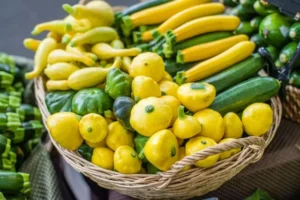Table of Contents
Introduction to Yellow Squash
In the culinary world, squashes are classified into two primary groups: summer squash and winter squash. Yellow squash, a popular member of the summer squash family, is often compared to its green counterpart, zucchini. Both share similar nutritional profiles and are valued for their versatility in various dishes.
What Makes Yellow Squash Unique?
Yellow squash (Cucurbita pepo) is easily recognized by its vibrant yellow skin, white flesh, and larger seeds compared to zucchini. Although similar in appearance, yellow squash has distinct characteristics that make it a unique addition to your kitchen. It’s smaller in size compared to zucchini and offers a slightly different texture and flavor.
Varieties of Yellow Squash
Yellow squash isn’t just a single type; there are several varieties available, each with its own unique attributes. Here are some popular types of yellow squash:
- Costata Romanesco: Known for its ribbed skin and nutty flavor.
- Eight-ball zucchini: A round squash, perfect for stuffing.
- Tatuma: Often used in Mexican cuisine, this squash has a mild flavor.
- Pattypan: Recognizable by its scalloped edges, it’s ideal for grilling.
- Cousa: A Middle Eastern variety, sweeter than others.
- Zephyr: A bi-colored squash with a delicate flavor.
Nutritional Profile of Yellow Squash
Yellow squash is celebrated for being low in calories, with just about 20 calories per one-cup serving of raw squash. It’s packed with essential nutrients that make it a healthy addition to any meal.

Nutritional Profile of Yellow Squash
Key Nutrients in Yellow Squash:
- Vitamins: Rich in vitamins A and C, yellow squash supports immune function, skin health, and vision.
- Minerals: Contains potassium and magnesium, crucial for heart health and blood pressure regulation.
- Fiber: Helps in digestion and maintaining a healthy weight.
Comparing Summer Squash and Winter Squash
A common question is whether summer squashes, like yellow squash, are as nutritious as winter squashes. The answer lies in their growth cycle. Winter squashes have a longer growing period, allowing them to accumulate more nutrients. They tend to be richer in carbohydrates and sugars, while summer squashes are lower in calories and carbs, making them ideal for weight management.
Health Benefits of Yellow Squash
Yellow squash offers numerous health benefits, contributing to various aspects of well-being:
1. Aiding in Weight Management
Due to its low-calorie content, yellow squash is perfect for those looking to lose or maintain weight. Its high water content ensures you can enjoy generous portions without consuming too many calories.
2. Providing Essential Antioxidants
The yellow skin of the squash is packed with antioxidants like beta-carotene, lutein, and zeaxanthin, which play a role in reducing oxidative stress and supporting eye health.
3. Supporting Heart Health
Potassium found in yellow squash helps regulate blood pressure, reducing the risk of heart disease. The fiber content also aids in lowering cholesterol levels.
How to Select and Store Yellow Squash
When purchasing yellow squash, look for ones that have smooth, vibrant yellow skin without blemishes or soft spots. Fresh squash should feel firm to the touch. To store, keep it in a loose plastic bag in the refrigerator where it can last up to a week.
Cooking with Yellow Squash
Yellow squash is incredibly versatile and can be prepared in numerous ways. Whether grilled, sautéed, or baked, it adds a delightful flavor and texture to any dish.
Cooking Tips:
- Grilling: Slice and grill with olive oil and your favorite herbs.
- Stir-Frying: Add to stir-fries for a burst of color and flavor.
- Baking: Use in casseroles or bake into breads and muffins for added moisture.
- Raw: Enjoy raw in salads or as a dipper for hummus.
Yellow Squash Recipes
Here are some delicious ways to incorporate yellow squash into your meals:
- Yellow Squash Lasagna: A low-carb alternative to traditional lasagna, layering slices of squash with ricotta and marinara sauce.
- Squash Frittata: A protein-packed breakfast option with eggs, yellow squash, and herbs.
- Stuffed Pattypan Squash: Hollow out pattypan squash and stuff with quinoa, vegetables, and cheese for a hearty meal.
Nutritional Comparison: Raw vs. Cooked
When it comes to retaining nutrients, both raw and cooked yellow squash offer benefits. Cooking can make certain nutrients more bioavailable, like beta-carotene, while raw squash retains more vitamin C. The key is to not overcook to preserve the delicate nutrients.
Yellow Squash in the Garden
For those interested in gardening, yellow squash is an easy and rewarding plant to grow. It thrives in warm weather and can produce abundant yields with minimal effort.
Conclusion
Yellow squash is a nutritional powerhouse with a myriad of culinary uses. Its low-calorie content, coupled with a rich supply of vitamins and minerals, makes it a valuable addition to any diet. Whether you’re looking to manage weight, support heart health, or simply enjoy a versatile vegetable, yellow squash is an excellent choice.